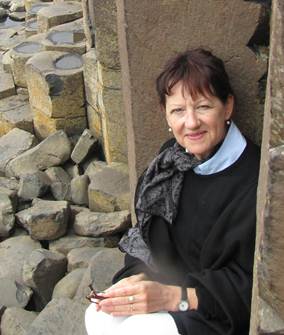Interviews
 Name: Christine Casey
Name: Christine Casey
Trinity Qualification: PhD (1992)
Title: Associate Professor in Architectural History
About: Christine Casey is an architectural historian with a particular interest in the relationship of architecture and decoration and the role of craftsmanship in architectural production. Her research has developed from an initial focus on Irish eighteenth-century architecture to a broader interest in European early modern architecture. She is currently leading an IRC New Horizons interdisciplinary research project entitled ‘Making Victorian Dublin’. Focused on the Museum Building at Trinity College Dublin this joint project with the Department of Geology is exploring the role of materials and craftsmanship in Dublin’s Victorian architecture.
When did you know you wanted to be an architectural historian?
I knew from an early age that history of art would be my area of study and was teased by friends about the narrowness of focus aged seventeen! While studying the history of art, architecture was the most compelling aspect of the course and an offer of a post-graduate studentship in architectural history sealed my fate!
What is most special to you about teaching at Trinity College Dublin?
The quality of the students, the great library collections of early printed material on architecture and the spectacular buildings which we have the privilege to use every day.
What first enticed you to explore the history of 18th century European craftsmen for your latest book?
I worked for three years as curator of two eighteenth-century houses on Saint Stephen’s Green (Newman House) which were richly decorated with plasterwork by the Swiss-Italian stuccatori, Paolo and Filippo Lafranchini and was determined to know more about their training in Europe and how their work in Ireland fitted into the wider picture of plasterwork production.
You are currently a Scholar-in-residence in Venice. Tell us briefly about what you are working on?
I was a scholar in residence at the Fondazione Giorgio Cini on the island of San Giorgio in Venice in March and April. The institute is housed in monastic building designed by Palladio and others and contains a wealth of material on Venetian architecture and on decoration in the wider sense. I was there to consult material for a project I am leading on the Museum Building at TCD, one of the first revivalist buildings in the Venetian-Gothic style and also to begin research for a book on the role of decoration in architecture.
What is your favourite building on campus and why?
The Museum Building for the boldness of its scale and the drama of its interior volumes, the richness of its carvings and the wonderful polychromy achieved outside and inside through the use of polished Irish stone
Tell us about the Irish Research Council Project you are involved in?
This is an interdisciplinary project with Geology. Instead of focusing on the design of the Museum Building, its architects etc, we are looking at how the building was made and what it tells us about the burgeoning industry in polished stone and stone carving in mid Victorian Ireland. We are showing where the stone comes from and how it was quarried, cut, transported and carved. In many ways this is a fusion of earth science, labour history and art history
What is your favourite era of architecture and why?
Much of my work has been focused on Georgian architecture and the wider architecture of the eighteenth century in Europe. However I teach across a broad chronological range and am interested in buildings of all periods. Due to the research project on the Museum Building I am increasingly drawn to the richness of nineteenth-century architecture.
What has been your proudest moment in your career to date?
Election as honorary member of the Royal Institute of the Architects of Ireland and election to fellowship at TCD. The completion and critical reception of my book on Dublin and more recently Making magnificence have also been very gratifying.

